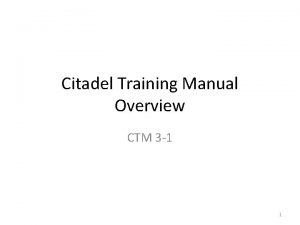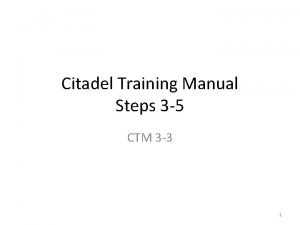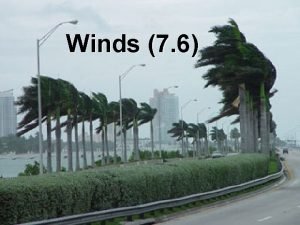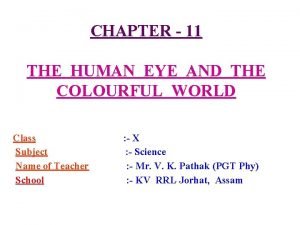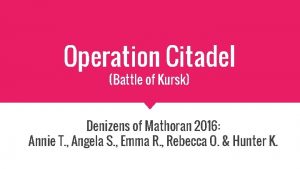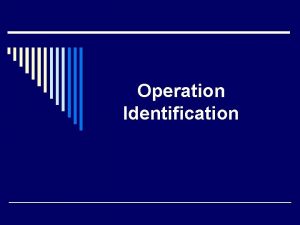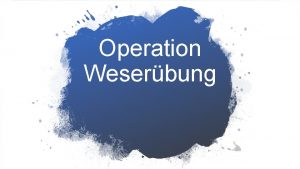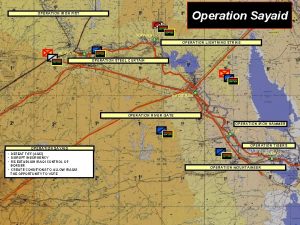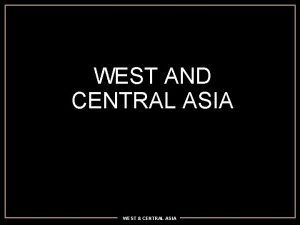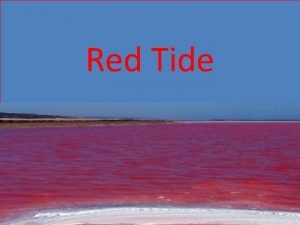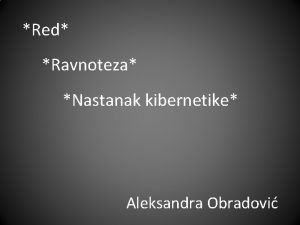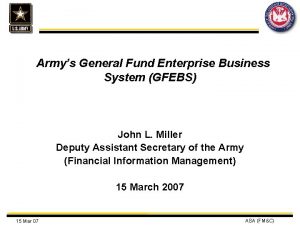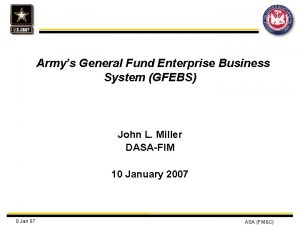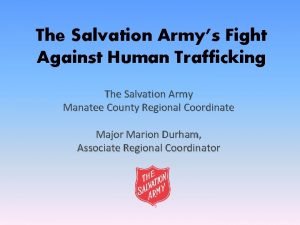Operation Citadel and the Red Armys advance west

























- Slides: 25

Operation Citadel (and the Red Army’s advance west) The Battle of Kursk Jeesoo Yoon, Olivia Ogren. Butail, Bethany Quevedo, Camille Adamson


Operation Citadel - What was it? - German plan to surround/cut off the Soviets and eliminate five of their armies at Kursk - Doing this would ensure that the Russians could not attack the Germans at Kharkov and Orel (Soviet cities) - Kharkov: Large Soviet Industrial Center Warfare History Network

Location Map Omniatlas

Google Maps Locations of Key Cities ● Map of current-day location of cities ● Orel and Kharkov are German territory prior to Battle of Kursk ● Soviets reclaim Orel and Kharkov

Movement Map Red - Germans Blue - Soviets Battleof. Kursk. org

Timeline ● 1943, beginning of the year - the Eastern front is at a stalemate. ● 1943, May 4 th- Planned launch date of Hitler’s Operation Citadel. Flickriver ● 1943, July 4 th- Launch of

Timeline Continued ● 1943, July 10 th- Second German attack on the southern side. It was “ more successful and led to the tank battle at the village of Prokhorovka”. ● 1943, July 11 th- Russian counterattack on the northern side. ● 1943, July 16 th- Hitler calls off Operation

Timeline Continued ● 1943, August 5 th- The Soviets recover the town of Orel ● 1943, August 23 th- The Soviets reclaim the town of Kharkov. Marks the end of the Battle of Kursk.

Battle Details: Key figures Ad Adolf Hitler Nikolai Fyodorovich Vatutin

Battle Details - Kursk was a turning point in the war (especially for the Soviets), as it was the first time a prime German summer offensive was stopped - The Germans intended to pinch off a salient (piece of land) in order to corner enemy soviet forces - The Soviets were aware of Germany’s attack, and planned to let them attack and wear out their forces before

Battle Details (con’t) - The Soviets successfully pushed the German forces back, retaking several towns such as Orel and Kharkov - From then on, the Germans were on the defensive on the eastern front The Battle of Kursk

Battle Details (con’t) - The Soviets based 1. 3 million soldiers in the Kursk bulge (Trueman) - Soviets had 20, 000 artillery pieces, 3, 600 tanks, and 2, 400 planes (Trueman) - The Germans prepared 900, 000 soldiers in the region - Germans had 10, 000 artillery guns, 2, 700 tanks, and 2, 000 aircraft (Trueman) - About ⅓ of all of Germany’s military strength was

Fun Facts - Was the largest tank battle in history - Ironically the German forces dealt more damage than they received even though they lost the battle - In only five days the Germans lost around ⅔ of their tanks to Soviet anti-tank guns - The Germans’ retreat was slowed by Russian partisans, who had destroyed the railroad to ensure that German trains would pile up, making them easy targets for the Russian air force

The Red Army’s Advance West - The Battle of Kursk was a turning point in the war for the Soviets as much as Stalingrad was, it put the Germans on the defensive permanently The Battle of Kursk - The Soviets liberated Romania & Bulgaria - In September, Soviets sent forces out to pursue the - The battle ended in July Germans

Thesis: Hitler’s delay of Operation Citadel allowed for the Soviet reinforcement of Kursk which led to the German casualties, sparking a turning point in World War II as the loss marked an end for German offensives in the East.

Evidence and Analysis Thesis: Hitler’s delay of Operation Citadel allowed for the Soviet reinforcement of Kursk which led to the German casualties, sparking a turning point in World War II as the loss marked an end for German offensives in the East. Hitler decided to delay Operation Citadel to acquire new technology for the battle This delay detrimental to German efforts USSR given intel about German plans Had time to prepare for the battle and reinforce the Kursk forces to keep the Germans away Tire the German troops out

Evidence and Analysis (con’t) Thesis: Hitler’s delay of Operation Citadel allowed for the Soviet reinforcement of Kursk which led to the German casualties, sparking a turning point in World War II as the loss marked an end for German offensives in the East. USSR strategy to tire Germans out worked USSR suffered heavier loss in terms of numbers Then why was this battle considered a German loss?

Evidence and Analysis (con’t) Thesis: Hitler’s delay of Operation Citadel allowed for the Soviet reinforcement of Kursk which led to the German casualties, sparking a turning point in World War II as the loss marked an end for German offensives in the East. Germany had less casualties in terms of numbers but suffered far more than USSR Germany did not have enough troops to replace the losses, while Russia had a large pool of resources to replenish troops from Germany fighting a 2 front war and does not have sufficient resources to replenish losses Absolutely devastating and irreparable damage to Germans

Evidence and Analysis (con’t) Thesis: Hitler’s delay of Operation Citadel allowed for the Soviet reinforcement of Kursk which led to the German casualties, sparking a turning point in World War II as the loss marked an end for German offensives in the East. As USSR pushed back, Red Army liberated multiple important cities, including Kharkov and Orel Regained territory Put Germans on the defensive line for the war at the eastern front This would not change until the end of the war Marked the German decline in the war in the east

Evidence and Analysis (con’t) Thesis: Hitler’s delay of Operation Citadel allowed for the Soviet reinforcement of Kursk which led to the German casualties, sparking a turning point in World War II as the loss marked an end for German offensives in the East. “The three immense battles of Kursk, Orel and Kharkov, all in the space of two months, heralded the downfall of the German army on the Eastern Front. ” - Winston Churchill Resulting from Hitler’s decision to delay the Operation Citadel, USSR was able to prepare for German attack and therefore resulted in the German loss, leading to the demise of Eastern Germany

Works Cited Axelrod, Alan. “Battle of Kursk. ” Encyclopedia of World War II, Vol. 2, Facts On File, 2013. History Research Center, online. infobase. com/Article/Details/264945? q=Battle of Kursk. Accessed 2017. "Battle of Kursk, 5 - 13 July 1943. " Chadwyck-Healey Atlas of World History, 2004, History Study Center, . Borrero, Mauricio. “Battle of Kursk. ” Russia, Facts On File, 2004. History Research Center, online. infobase. com/Article/Details/248368? q=Battle of Kursk. Accessed 2017. Knapp, Wilfrid F. , and John Lukacs. "Adolf Hitler. " Encyclopædia Britannica, Inc. , 02 Sept. 2015. Web. 01 May 2017. <https: //www. britannica. com/biography/Adolf-Hitler>.

Works Cited (con’t) Map of Europe 1943. Digital image. Historical Atlas of Russia. Omniatlas, n. d. Web. 24 Apr. 2017. <http: //omniatlas. com/maps/russia/19430704/> Map of the Battle of Kursk. Digital image. Battle of Kursk. N. p. , n. d. Web. 24 Apr. 2017. <http: //www. battleofkursk. org/Battle-of-Kursk-Map. html> Polly, Martin. "Kursk, Battle of (July 1943). " History Study Center. Pro. Quest, 2000. Web. 24 Apr. 2017.

Works Cited (con’t) "The World at War, 1914 -1945. " World History: The Modern Era, ABC-CLIO, 2017, worldhistory. abc-clio. com/Search/Display/340469. Accessed 24 Apr. 2017. Trueman, C. N. "The Battle of Kursk. " History Learning Site. N. p. , 21 May 2015. Web. 24 Apr. 2017. <http: //www. historylearningsite. co. uk/world-war-two/famous-battles-of-world-wartwo/the-battle-of-kursk/>.

Works Cited (con’t) “The Battle of Kursk. ” Battle of Kursk: Eastern Front 1943, www. battleofkursk. org/. Accessed 24 Apr. 2017. Waffen, Krueger. “German Soldiers of SS Troops. ” Flickriver, 4 Jan. 2013, www. flickriver. com/photos/kruegerrossi/8348931817/. Accessed 24 Apr. 2017. Watts, Tim. "Battle of Kursk. " World History: The Modern Era, ABC-CLIO, 2017, worldhistory. abc-clio. com/Search/Display/309509. Accessed 19 Apr. 2017
 Operation citadel ww2
Operation citadel ww2 Operation citadel map
Operation citadel map East is east and west is west
East is east and west is west Citadel pillars of strength
Citadel pillars of strength Handshake citadel
Handshake citadel Citadel cqr sheet
Citadel cqr sheet The citadel counseling center
The citadel counseling center Erbil citadel ppt
Erbil citadel ppt The citadel ctm
The citadel ctm Citadel ctm
Citadel ctm Wind is horizontal movement of air
Wind is horizontal movement of air Name of the wind series
Name of the wind series West oost zuid noord
West oost zuid noord Old west vs new west
Old west vs new west Operation red block
Operation red block A red red rose theme
A red red rose theme Metaphor in stereo hearts
Metaphor in stereo hearts Difference between loan and advance
Difference between loan and advance Cues and questions
Cues and questions Advantages and disadvantages of advance directives
Advantages and disadvantages of advance directives Advance sunrise and delayed sunset is due to
Advance sunrise and delayed sunset is due to Click roll and advance
Click roll and advance Marzanos instructional strategies
Marzanos instructional strategies Cues questions and advance organizers
Cues questions and advance organizers Problem solving videos
Problem solving videos Economic advance and social unrest
Economic advance and social unrest








